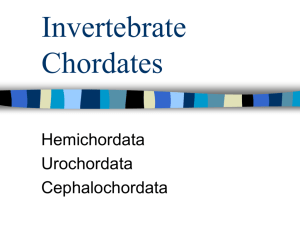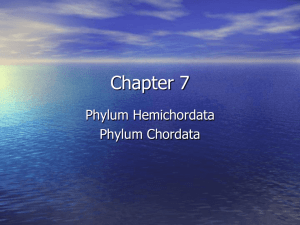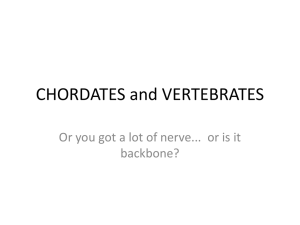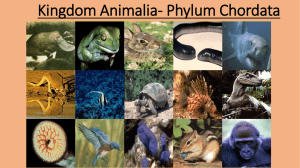Intro to chordates
advertisement
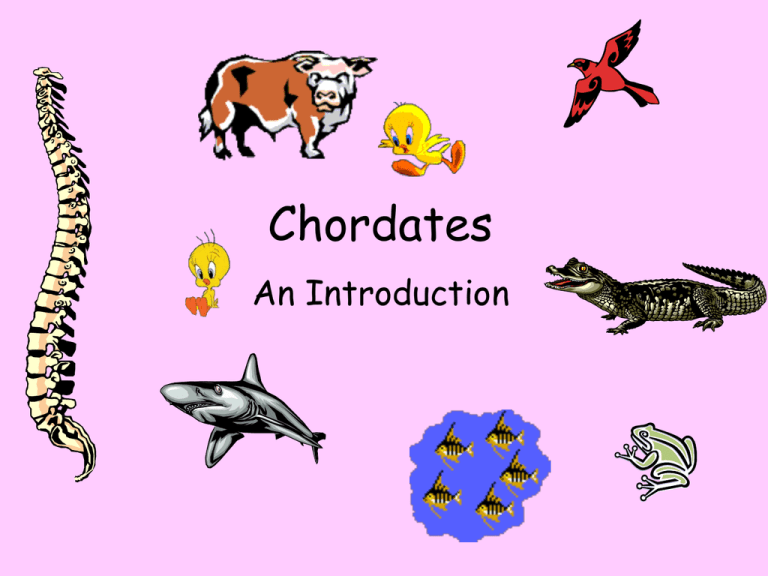
Chordates An Introduction Kingdom Animalia- All inverts & verts 1. Phylum Chordata: All have nerve cords. 3 subphyla : A- Urochordata (tunicates aka sea squirts). Only larvae have notochord B-Cephalochordata (lancelets aka Amphioxus). Retain notochord throughout adulthood, but “musclelike” for burrowing C-Vertebrata- Notochord becomes backbone. 7 Classes Section 33-1 Concept Map Chordates have the following key features Notochord which is Dorsal hollow nerve cord Postanal tail Pharyngeal gill slits/ pouches The Generalized Structure of a Chordate: Section 30-1 A flexible supporting structure We even start out this way in the womb! Notochord Muscle segments Tail Hollow nerve cord Anus Mouth Pharyngeal pouches Chordates 4 Phylum Chordata 5 Phylum Chordata • Notochord • Gill slits or pharyngeal pouches • Dorsal hollow nerve cord • Postanal tail • Segmented muscles • Deuterostome 6 7 8 9 10 Evolutionary Adaptations of Chordates • From filter feeding ancestors to active predators – – – – – Mobility Oxygen capture Digestion Circulation Nervous system 11 Skeletal Changes • Skeleton becomes stronger to work with bigger muscles • Allows more rapid movement 12 Oxygen Capture • Gill slit and muscular pharynx will move more water over gills – More oxygen is extracted from water 13 Circulation • Stronger heart to circulate blood faster 14 Digestion • Digest more food – Muscularized gut – Digestive glands • Liver • Pancreas 15 Nervous System • More complex for better – Motor control of body to capture food – Sensory detection of the animals environment – Integration centers (brain) 16 Brain With Three Parts Hindbrain Midbrain Forebrain 17 Section 33-1 Nonvertebrate chordates Jawless fishes Cartilaginous fishes Bony fishes Amphibians Reptiles Birds Mammals Figure 33–2 A Cladogram of Chordates Chordate Cladogram Mammals Birds Amphibians Fishes Nonvertebrate chordates Invertebrate ancestor Reptiles Figure 33–4 Diversity of Chordates Section 33-1 Nonvertebrate chordates (4%) Mammals (8%) Birds (18%) Reptiles (14%) Amphibians (9%) Fishes (47%) Chordate Subphyla Phylum. Chordata Urochordata Subphylum. Cephalochordata Subphylum. Vertebrata Subphylum. 21 Sea Squirts 22 Subphylum Urochordata • Sea squirts (aka tunicate) • Gill slits (pharyngeal slits) • Notochord – Only in larva • Adult has tunic- made of cellulose, sessile • http://www.arkive.org/starascidian/botryllusschlosseri/ • http://finstofeet.wordpress.c om/2010/03/14/1-2-behold- 23 24 25 26 Subphylum Cephalochordata • Amphioxus (lancelets) • Notochord length of body • Dorsal hollow nerve cord • Gill slits • Segmented muscles • Maintain all chordate characteristics as adult 27 Amphioxus 28 Amphioxus 29 Subphylum Vertebrata: All Vertebrates have: • • • • • Endoskeleton- backbone Closed circulatory system Bilateral symmetry True coelom Sexual reproduction- internal or external Vertebrate Groups- Fish, Amphibians, Reptiles, Birds, and Mammals Homeostasis • Endothermic (warm-blooded)- internal temp. regulation that must be maintained Ex. Birds & Mammals • Ectothermic (cold-blooded)- external temp. regulation/ regulated by environment Ex. Nonvertebrate chordates, Fish, Amphibians, Reptiles Temperature Control in Chordates Body Temperature (°C) Section 33-2 Environmental Temperature (°C) 98.6 F- avg human temp How vertebrates maintain their temperature Animal Group Endo/ectotherm Behavior/structure Fish Ectotherm Swim bladder: Cold/move up Hot/move down Amphibian Ectotherm Cool/go in sun Hot/go to water Reptile Ectotherm Cool/bask Hot/go to water Birds Endotherm Cool/fluff feather Hot/raise wings Mammals Endotherm Sweat, pant, shiver Kingdom Animalia Phylum Chordata Subphylum Vertebrata Class Agnatha “Jawless” Fish (most primitive): Traits: -Sucker like mouth(no jaws) -No fins or paired appendages -Cartilage skeleton w/ notochord Ex: lamprey & hagfish Kingdom Animalia Phylum Chordata Subphylum Vertebrata Class Chondrichthyes-Cartilage Fish Traits: Cartilage skeleton; 2 chambered heart Lateral line system –detect vibrations (movement & sense) Paired appendages- pectoral and pelvic girdles Poor eyesight, great olfactory Carnivorous or scavenger, no swim bladder Ex: sharks, skates, rays http://missbakersbiologyclass.com/blog/2009/ 04/06/dogfish-shark-dissection-includesvideo/ Fish Scales Tails Sharks and rays lungfish Bony fish Fish Tail Cladogram Kingdom Animalia Phylum Chordata Class Osteichthyes- Bony Fish Traits: Bony skeleton; 2 chambered heart Lateral line system/movement & sense Swim bladder-control depth (buoyancy) Have operculum over gills Good smell (olfactory) and eyesight Ex: perch, bass, flounder

